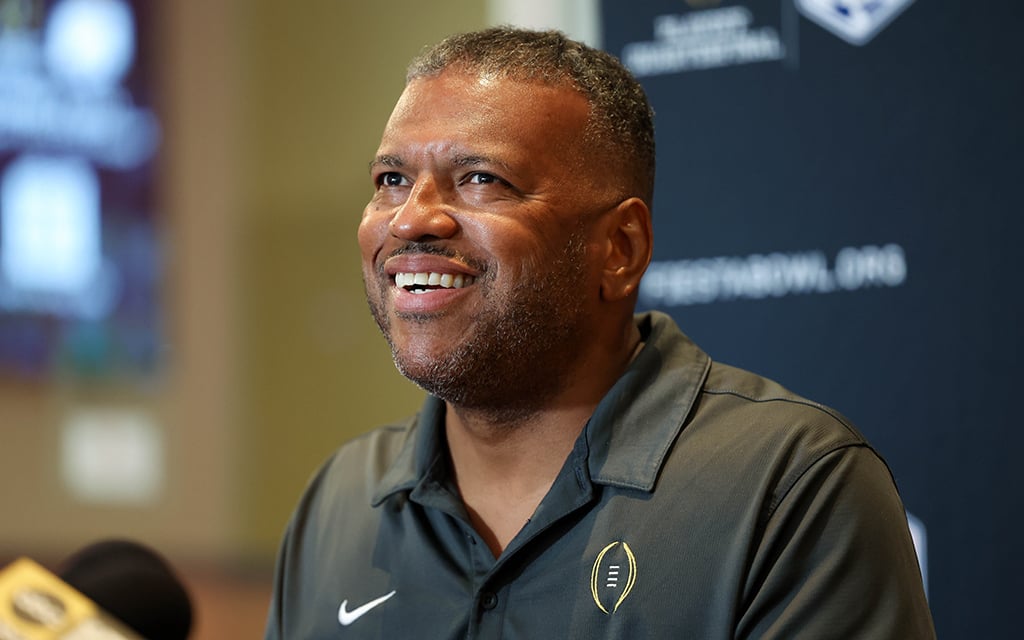SCOTTSDALE – Richard Clark, the newly appointed College Football Playoff executive director, is not going to reinvent the wheel under his new title, even as the landscape of not only college football, but also all of college sports, is shaping and shifting like never before.
“Right now, there’s a lot of change already, and it’s exciting,” Clark said Tuesday at Fiesta Bowl headquarters. “I think people are going to see things that they never imagined in what happens during this playoff.”
Part of the change is the novel 12-team CFP playoff format that Clark is inheriting, which he is preparing extensively for with training and the reliance on his selection committee to make the proper choices.
Under the new CFP format, the four highest-ranked conference champions will get automatic bids and a bye week, while the fifth-ranked conference champion will land anywhere below that depending on its final ranking in the Top 25.
For example, if that fifth conference champion is ranked 20th in the Top 25 by the end of the season, that team will be bumped to the No. 12 seed in the CFP.
Seeds 5 through 12 will be placed at the discretion of the 13-member selection committee. Per usual, controversy could ensue in relation to the teams the committee admits or does not admit.
“I think it makes every Saturday even more exciting,” said Clark, who, after a distinguished 38-year career in the Air Force, replaced the retiring Bill Hancock in the sport’s premier role.
As sports fans know, one loss could almost completely eliminate a team from playoff contention, but now it is expected that multiple-loss teams will make up the latter part of the bracket, and maybe the conference champions as well.

Erik Moses, Vrbo Fiesta Bowl executive director and CEO, discusses the new College Football Playoff format and the Fiesta Bowl’s involvement in it. (Photo by Spencer Barnes/Cronkite News)
This is due to the increased competition in each league because of conference realignment, the popularity of NIL (name, image and likeness) that allows college athletes to earn money from their personal brand and the expansion of the playoff field.
The CFP, much like the NCAA and other related college sports organizations, is trying to find ways to adapt business logistics amid these changes.
Whereas realignment and NIL could be seen as more of a negative in certain ways for athletes and coaches, the CFP is counting on playoff expansion being a positive engine to boost fan interest and engagement as the season progresses.
Erik Moses, executive director and CEO of the Fiesta Bowl, loves the automatic investment that comes with a 12-team playoff.
“It’s a wider field and there are more fan bases that can be built into the storylines,” Moses said.
As the five highest-ranked champions get the top five seeds in the CFP, what about those teams that lose in the conference championship?
Clark trusts the committee to make the right decisions, but makes a distinction for conference championship contenders that fall short.
“A team that is willing to go into the championship and put it on the line and play well is probably a team that’s good enough for strong consideration in the rankings,” Clark said.
The CFP will look at “the entire body of work” of a team and how it has played leading up to the championship game, while some reverence will be paid to those losing teams if they perform well.
They will not be “overly penalized” for losing the game outright.
“It’s going to have another dynamic this year because we’ll go from rankings to seedings,” Moses said. “I have confidence that the folks in that room know enough about football that they’ll make the right decisions.”
Much of the same criteria is still set in place for choosing the “best” teams in the country to compete for the national championship – with points of emphasis being strength of schedule, quality of competition, performance against common opponents as compared to other programs, and the consistency of performance across the season.
The conference a team plays in has no explicit bearing on the rankings, but strength of schedule is inherently impacted by conference play. Therefore, conference association still has much influence on where a team will be ranked, if at all, in the top 12.
It’s been made clear that picking playoff teams is not an easy task, as a 13-member committee is bound to have dissenting opinions.
The use of discretion invites error in the eyes of fans, which means anger and disappointment are inevitable. This is why the selection committee analyzes games down to the tee.
Discussions on rankings can be lengthy and hotly contested.
“The discussions are intense because they’re all experts,” Clark said. “It’s a very rigorous process.”
Efforts to decide the final bracket extends for five weeks and out of that the CFP is formed.
With the college football landscape important to so many Americans, Clark understands the role he is stepping into.

A wall of Division I college football helmets sit upon a huge display inside the Fiesta Bowl museum in Scottsdale. (Photo by Spencer Barnes/Cronkite News)
He feels like his extensive time in the Air Force has helped him generate the fervor for a job like this, with so many eyes on the results coupled with the high level of investment from fans and sponsors.
“Every day that I get up, I think about college football and the best days in America,” said Clark, who most recently served as the superintendent for the U.S Air Force Academy where he was a four-year letter winner as a defensive lineman before graduating in 1985.
Being in charge of the CFP is a stark contrast to the preparation in the military that goes into preventing and staying ready for “the worst days in America,” he said.
Clark says he was considered a “non-traditional candidate” by the search committee that recommended he admit his name into the running for the position, yet he ended up with the job and started on June 4, just three days after leaving the Air Force.
Now, as the first full week of the college football season is ready to begin, Clark and the CFP are already getting prepared for New Year’s.
The Fiesta Bowl in Glendale will be the first CFP quarterfinal game, which will kick off the festivities on December 31.
Moses considers the Phoenix metropolitan area one of the best destinations in America come December and January.
“We want to make certain that people understand the luxury they have of having a New Year’s Six bowl in their backyard, year over year,” Moses said.
All eyes will be on the running of these New Year’s Six bowl games, which will start the culmination of this unprecedented year of college football marked by conference realignment.
On paper, and hopefully on the gridiron, this college football season will be unlike any other.


